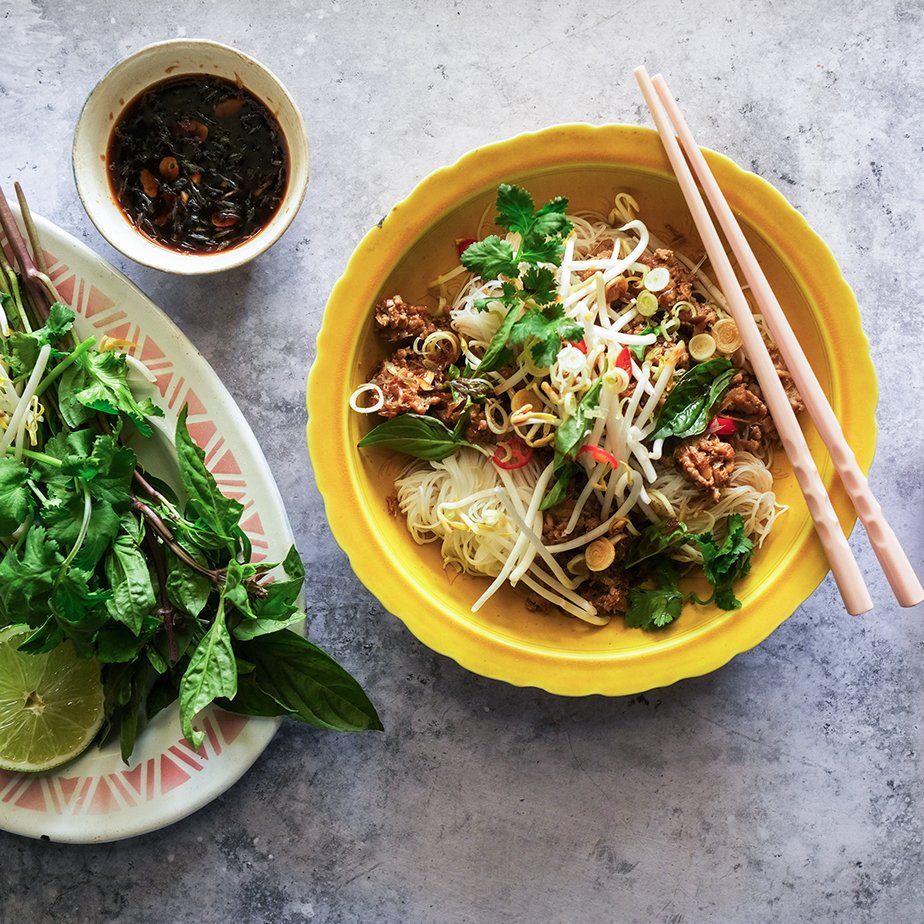Glazed eggplant with rice, jammy eggs and spring onion salad
Soon, we pinky swear, we’ll do a deep dive into Korean ingredients because we realise not everyone is fluent. And Korean food has become SO popular that you might want to whip up a few dishes at home. If you don’t know your gochujang from your gochugaru you can still easily make this recipe, but you will need to get your hands on both. Just bee-line to a decent Asian food store, although you’ll probs find gochujang at a major supermarket. It’s a delightfully lush, gluggy, sticky-sweet chilli paste, while gochugaru is a chilli powder that’s milder and slightly smokier than bog standard. You can’t really use substitutes for either. The rice syrup is another foundational Korean ingredient; thick and oozy, it’s made from rice and barley malt powder and it’s the amylase enzyme in sprouted barley that gives it natural sweetness. It’s way less sickly than honey or sugar so these aren’t great substitutes… again, rice syrup shouldn’t be hard to find in an Asian or Korean grocer.
Pro-tip; for the jammy eggs, have your timer and iced water both at the ready before you get cooking. We over-did ours by a smidge (it’s easy to do)… 30 seconds here or there really makes a big difference so accuracy is everything. The iced water cools them super fast so they don’t keep cooking and ruin that alluring, oozy effect; cold running tap water will not cut it here. You need actual ice. And hey, if eggplant isn’t your thing, this would work with chicken. Especially skin-off, Frenched chicken legs (use 8 to serve 4), or chicken thigh fillets. Cook them through, then glaze them in a large pan with the gochujang mix and you’re good to go.
SERVES 4
1.2 kg eggplant (about 2 large)
salt
420g (2 cups) sushi rice
4-6 eggs, at room temperature
60ml (¼ cup) Japanese rice vinegar
2½ tbsp caster sugar
1 tbsp mirin
100ml vegetable oil, approximately
toasted sesame seeds, for sprinkling
kimchi, to serve (optional)
Glaze
2-2½ tbsp gochujang (Korean chilli paste), to taste
2 tbsp Korean rice syrup
2 tbsp light soy sauce
2 tbsp mirin
1 tbsp sesame oil
2 garlic cloves, very finely grated or chopped
2 tsp very finely grated or chopped ginger
Spring onion salad
5-6 spring onions, trimmed and cut into fine shreds
2½ tbsp rice vinegar
2 tbsp caster sugar
3-4 tsp gochugaru (Korean chilli powder), to taste
3-4 tsp light soy sauce
1 tbsp sesame oil
Trim the eggplant, then cut into rounds about 1cm thick. Cut any large rounds into half moons. Layer the eggplant in a large colander, sprinkling each layer lightly with salt. Stand over a sink for 30 minutes to allow excess liquid to drain. Rinse well, drain, then lay on layers of clean paper towel to dry. Meanwhile, combine all the glaze ingredients in a bowl and stir to mix well. Set aside.
Rinse the rice, then drain it well. Combine in a saucepan with 750ml (3 cups) water, bring to the boil, then cover the pan tightly and cook over medium heat for 10 minutes. Without removing the lid, remove the pan from the heat, then stand for 15 minutes for the rice to finish cooking.
While the rice is cooking, bring a small saucepan of water to the boil for the eggs. Fill a bowl with iced water. Cook the eggs in simmering water over medium heat for 6 minutes, then drain well and cool in the iced water. Peel and set aside. When the rice is ready, transfer to a large bowl, sprinkle over the vinegar, sugar and mirin, then use a plastic rice paddle or spatula to gently mix the rice to coat well. Use a fan as you mix to cool the rice down. Cover the rice and set aside.
For the spring onion salad, place the spring onion in a large bowl of cold water, then stand for 6-8 minutes or until the shreds curl a little. Drain well. Combine the remaining ingredients in a large bowl, stir to mix well, then set aside.
Heat half the oil in a large, heavy-based frying pan over medium-high heat. Add enough eggplant slices to fill the pan in a single layer, then cook for 8-9 minutes, turning once, or until golden and tender. Remove to a bowl then cook the remaining eggplant; if you have two pans, you can cook more at the same time, adding extra oil as necessary. When all the eggplant is cooked, add the glaze and all the eggplant to the pan, then toss for 2-3 minutes or until the glaze bubbles and coats the eggplant. Remove from the heat.
Add the spring onion to the dressing in the bowl and toss to coat. Serve the eggplant scattered with sesame seeds, with the rice, spring onion salad and kimchi, if you like.






